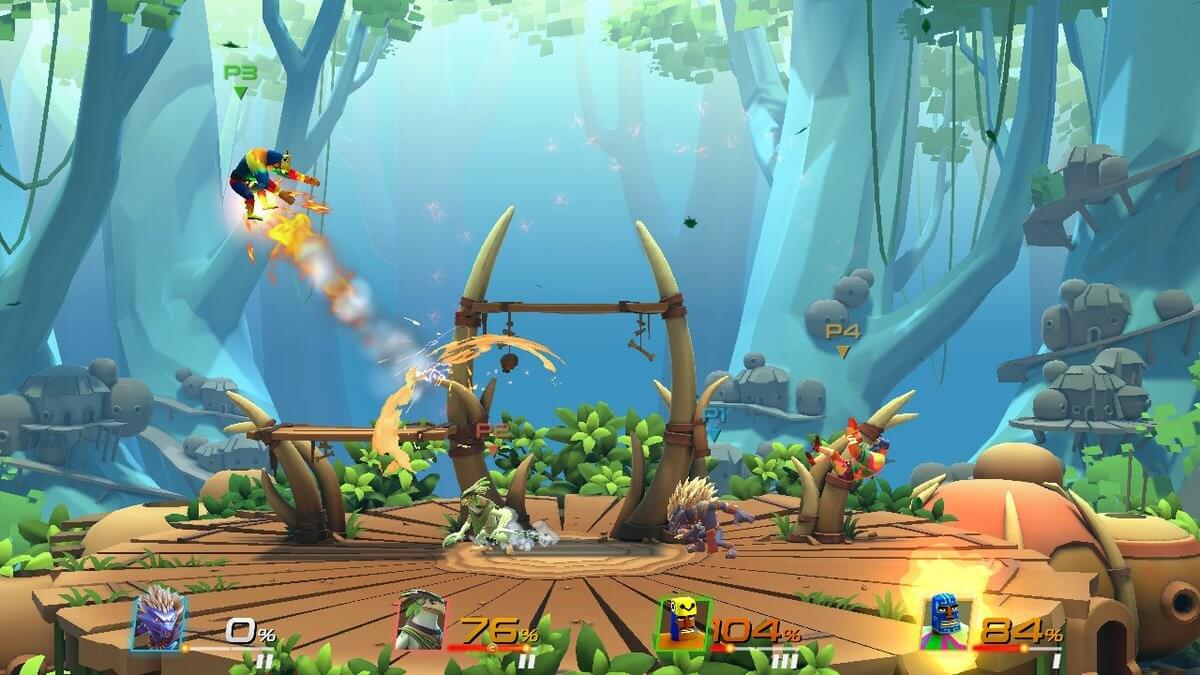The Switch has had a fantastic first year, but one of the big Nintendo franchises the console is still missing is the much-beloved Super Smash Bros.. While rumors are swirling about some sort Super Smash Bros. 4 port to Switch, a few enterprising indie developers are looking to fill the void with Smash-inspired fighters of their own. One such effort is Angry Mob Games‘ Brawlout. While it makes a valiant attempt to put its own spin on the Smash style of platform fighting gameplay, Brawlout has some notable issues that aren’t easily overlooked.
It’s worth noting from the outset that the game is designed for competitive Smash fans. If you’re looking for a goofy free-for-all with zany items and copious stage hazards, this isn’t the game you want. What’s here is a very basic selection of fighting arenas with restrained gimmickry, no items, and a handful of game modes that are focused specifically on pure fighting.
If you’re familiar with Smash, the controls in Brawlout will feel like second nature. You have a regular attack button and a special attack button, and pressing these in combination with a directional input will change your attacks. Jumping and running also change your attack properties, and you can charge certain attacks for more power. The goal is to damage your opponent, then hit them hard enough to send them flying off the field. Sounds exactly like Smash so far, right? The big difference is that Brawlout doesn’t offer shielding or grab maneuvers. Instead, the buttons you would normally associate with these moves are re-assigned to a dodge move with an invincibility window that can be executed on the ground or in the air.











While dodging is a mechanic that veteran Smash players will no doubt feel familiar with, the removal of shielding and grabs is quite puzzling. The lack of guard and throw mechanics, which are are nearly universal across all kinds of fighting games, limits your options in frustrating ways. The loss of shielding, for example, makes certain attacks a lot safer than they would be in other games of this sort, and puts a lot of power in the hands of someone going all-in on aggression. It doesn’t necessarily result in a more aggressive game; it just gives someone on the defending side fewer options and leads to more frustration.
Brawlout attempts to cover for the loss of these options with an upgraded Rage mechanic. Rage was something of a hidden mechanic in Smash 4 that would increase a character’s damage output when they had taken a lot of damage. In Brawlout, Rage is very clearly visible through a meter shown underneath a character’s damage readout. As a character takes damage, their meter increases. They can use the meter to power up their special attacks, utilize a combo-escaping burst when the meter’s at least half full, or enter full-on Rage Mode (indicated by a large burning flame graphic on the character’s damage indicator) when it’s at max. Special moves have different properties when used with and without Rage meter to fuel them, so keeping tabs on your meter becomes a big part of the game at higher levels of play.
Brawlout presents its comic combatants and arenas with confidence and style, but even the game’s relatively bland-looking characters prove useful during battle. Joining the cast of original fighters are two guests from other indie games: Juan from Guacamelee and the Drifter from Hyper Light Drifter. They both feel at home in the game, but as of this writing, Drifter is somewhat overpowered compared to the rest of the cast.
However, in order to access the full selection of characters and stages, you have to unlock them. And there is a lot of unlocking to do. Fighting on- and offline, completing the tutorials and arcade modes, leveling up characters, and fulfilling daily objectives will all earn you currency you can spend on „pinatas“ (read: loot boxes) to earn characters, skins, and other goodies. To unlock more than three initial stages, you have to level up specific characters across numerous fights. No, you can’t just find one fighter you really click with and play with them; you need to play each character until you reach a specific level for them to unlock one stage apiece. And that’s a separate grind from the two different in-game currencies.
With the game being so slanted towards competitive play, Brawlout does its best to push you towards playing online. The problem is that, in its current state, online play is a mess. I had a handful of good sessions in my attempts to play online. By and large, my online bouts were defined by stuttering, clunky-feeling movement and laggy slideshows–issues echoed online by other players. It’s hard to recommend a competition-focused game like this when part of its foundation is so flawed.
Brawlout is clearly trying its best to create a unique identity from the game that inspired it. However, the ways in which it’s trying to do this–by removing key mechanics and putting an emphasis on grindy unlocks–don’t work in its favor. Combine this with an online mode that just doesn’t seem to function correctly most of the time and you’ve got a game that’s disappointing in its current form. Keep the Wii U or GameCube hooked up to get your Smash fix for now.
Website: LINK


